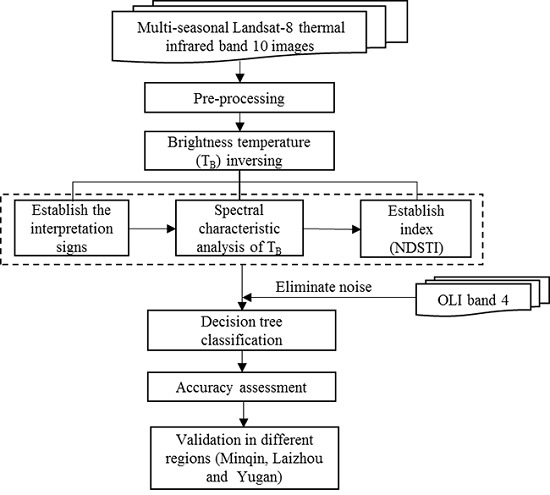A Strategy of Rapid Extraction of Built-Up Area Using Multi-Seasonal Landsat-8 Thermal Infrared Band 10 Images
Abstract
:1. Introduction
2. Methodology
2.1. Data Sources and Pre-Processing
2.2. Brightness Temperature
2.3. Built-Up Area Extraction
2.3.1. The Index for the Built-Up Area Extraction Tree
2.3.2. Accuracy Assessment
2.4. Comparison with Other Methodologies
2.5. Validation in Another Three Areas
3. Results
3.1. The Extraction Results of the Tangshan Study Area
3.2. The Results of a Comparison with Other Methodologies
3.3. The Validation Results in Three Other Areas
4. Discussion
5. Conclusions
Acknowledgments
Author Contributions
Conflicts of Interest
References
- Slonecker, E.T.; Jennings, D.B.; Garofalo, D. Remote sensing of impervious surfaces: A review. Remote Sens. Rev. 2001, 20, 227–255. [Google Scholar] [CrossRef]
- Cohen, B. Urbanization in developing countries: Current trends, future projections, and key challenges for sustainability. Technol. Soc. 2006, 28, 63–80. [Google Scholar] [CrossRef]
- Du, P.; Li, X.; Cao, W.; Luo, Y.; Zhang, H. Monitoring urban land cover and vegetation change by multi-temporal remote sensing information. Int. J. Min. Sci. Technol. 2010, 20, 922–932. [Google Scholar] [CrossRef]
- Lambin, E.F.; Geist, H.J. Global land-use and land-cover change: What have we learned so far? Glob. Chang. Newslett. 2001, 46, 27–30. [Google Scholar]
- Bertrand-Krajewski, J.L.; Barraud, S.; Chocat, B. Need for improved methodologies and measurements for sustainable management of urban water systems. Environ. Impact Assess. Rev. 2000, 20, 323–331. [Google Scholar] [CrossRef]
- Estoque, R.C.; Murayama, Y. Classification and change detection of built-up lands from Landsat-7 ETM+ and Landsat-8 OLI/TIRS imageries: A comparative assessment of various spectral indices. Ecol. Indic. 2015, 56, 205–217. [Google Scholar] [CrossRef]
- Xu, H. A new index for delineating built-up land features in satellite imagery. Int. J. Remote Sens. 2008, 29, 4269–4276. [Google Scholar] [CrossRef]
- Griffiths, P.; Hostert, P. Mapping megacity growth with multi-sensor data. Remote Sens. Environ. 2010, 114, 426–439. [Google Scholar] [CrossRef]
- Guindon, B.; Zhang, Y.; Dillabaugh, C. Landsat urban mapping based on a combined spectral-spatial methodology. Remote Sens. Environ. 2004, 92, 218–232. [Google Scholar] [CrossRef]
- Maktav, D.; Erbek, F.S.; Jürgens, C. Remote sensing of urban areas. Int. J. Remote Sens. 2005, 26, 655–659. [Google Scholar] [CrossRef]
- Bordbari, R.; Maghsoudi, Y.; Salehi, M. Detection of built-up areas using polarimetric synthetic radar data and hyperspectral image. ISPRS Int. Arch. Photogramm. Remote Sens. Spat. Inf. Sci. 2015, 40, 105–110. [Google Scholar] [CrossRef]
- Tolpekin, V.A. Detection of built-up area in optical and synthetic aperture radar images using conditional random fields. J. Appl. Remote Sens. 2014, 8, 083672. [Google Scholar]
- Xiang, D.; Tang, T.; Hu, C.; Fan, Q.; Su, Y. Built-up area extraction from polSAR imagery with model-based decomposition and polarimetric coherence. Remote Sens. 2016, 8, 685. [Google Scholar] [CrossRef]
- Pesaresi, M.; Gerhardinger, A.; Kayitakire, F. A robust built-up area presence index by anisotropic rotation-invariant textural measure. IEEE J. Appl. Remote Sens. 2009, 1, 180–192. [Google Scholar] [CrossRef]
- Li, Y.; Tan, Y.; Deng, J.; Wen, Q.; Tian, J. Cauchy graph embedding optimization for built-up areas detection from high-resolution remote sensing images. IEEE J. Sel. Top. Appl. Earth Obs. Remote Sens. 2015, 8, 2078–2096. [Google Scholar] [CrossRef]
- Chen, Y.; Qin, K.; Jiang, H.; Wu, T.; Zhang, Y. Built-up area extraction using data field from high-resolution satellite images. Geosci. Remote Sens. Symp. 2016, 437–440. [Google Scholar] [CrossRef]
- Lu, D.; Weng, Q. Spectral mixture analysis of the urban landscape in Indianapolis with Landsat ETM+ imagery. Photogramm. Eng. Remote Sens. 2004, 70, 1053–1062. [Google Scholar] [CrossRef]
- Jat, M.K.; Garg, P.K.; Khare, D. Monitoring and modelling of urban sprawl using remote sensing and GIS techniques. Int. J. Appl. Earth Obs. 2008, 10, 26–43. [Google Scholar] [CrossRef]
- Tong, S.; Koller, D. Support vector machine active learning with applications to text classification. J. Mach. Learn. Res. 2002, 2, 45–66. [Google Scholar]
- Bhaskaran, S.; Paramananda, S.; Ramnarayan, M. Per-pixel and object-oriented classification methods for mapping urban features using Ikonos satellite data. Appl. Geogr. 2010, 30, 650–665. [Google Scholar] [CrossRef]
- Chen, Y.; Shi, P.; Fung, T.; Wang, J.; Li, X. Object-oriented classification for urban land cover mapping with ASTER imagery. Int. J. Remote Sens. 2007, 28, 4645–4651. [Google Scholar] [CrossRef]
- Lu, L.; Di, L.; Ye, Y. A decision-tree classifier for extracting transparent plastic-mulched landcover from Landsat-5 TM Images. IEEE J. Sel. Top. Appl. Earth Obs. Remote Sens. 2014, 7, 4548–4558. [Google Scholar] [CrossRef]
- Zhang, Y.; Ma, X.; Chen, L. Extraction and change detection of urban impervious surface using multi-temporal remotely sensed data. Proc. SPIE Int. Soc. Opt. Eng. 2006. [Google Scholar] [CrossRef]
- Novelli, A.; Tarantino, E.; Caradonna, G.; Apollonio, C.; Balacco, G.; Piccinni, F. Improving the ANN classification accuracy of Landsat data through spectral indices and linear transformations (PCA and TCT) aimed at LU/LC monitoring of a river basin. Lect. Notes Comput. Sci. 2016, 9787, 420–432. [Google Scholar]
- Apollonio, C.; Balacco, G.; Novelli, A.; Tarantino, E.; Piccinni, A.F. Land use change impact on flooding areas: The case study of Cervaro Basin (Italy). Sustainability 2016, 8, 996. [Google Scholar] [CrossRef]
- Tripathi, N.K. Built-up area extraction using Landsat 8 OLI imagery. GISci. Remote Sens. 2014, 51, 445–467. [Google Scholar]
- Novelli, A.; Tarantino, E. Combining ad hoc spectral indices based on LANDSAT-8 OLI/TIRS sensor data for the detection of plastic cover vineyard. Remote Sens. Lett. 2015, 6, 933–941. [Google Scholar] [CrossRef]
- Senanayake, I.P.; Welivitiya, W.D.D.P.; Nadeeka, P.M. Remote sensing based analysis of urban heat islands with vegetation cover in Colombo city, Sri Lanka using Landsat-7 ETM+ data. Urban Clim. 2013, 5, 19–35. [Google Scholar] [CrossRef]
- Jiang, Z.; Chen, Y.; Jing, L. On urban heat island of Beijing based on Landsat TM data. Geo-Spat. Inf. Sci. 2006, 9, 293–297. [Google Scholar]
- Mallick, J.; Kant, Y.; Bharath, B.D. Estimation of land surface temperature over Delhi using Landsat-7 ETM+. J. Indian Geophys. Union 2008, 12, 131–140. [Google Scholar]
- Tran, H.; Uchihama, D.; Ochi, S.; Yasuoka, Y. Assessment with satellite data of the urban heat island effects in Asian mega cities. Int. J. Appl. Earth Obs. 2006, 8, 34–48. [Google Scholar] [CrossRef]
- The United States Geological Survey (USGS), USGS Global Visualization Viewer (GloVis). Available online: http://glovis.usgs.gov/ (accessed on 4 November 2017).
- Barsi, J.; Schott, J.; Hook, S.; Raqueno, N.; Markham, B.; Radocinski, R. Landsat-8 Thermal Infrared Sensor (TIRS) Vicarious Radiometric Calibration. Remote Sens. 2014, 6, 11607–11626. [Google Scholar] [CrossRef]
- Irons, J.R.; Dwyer, J.L.; Barsi, J.A. The next Landsat satellite: The Landsat Data Continuity Mission. Remote Sens. Environ. 2012, 122, 11–21. [Google Scholar] [CrossRef]
- Washburne, J.C. A Distributed Surface Temperature and Energy Balance Model of a Semi-Arid Watershed. Ph.D. Thesis, University of Arizona, Tucson, AZ, USA, 1994. [Google Scholar]
- Wukelic, G.E.; Gibbons, D.E.; Martucci, L.M.; Foote, H.P. Radiometric calibration of Landsat Thematic Mapper thermal band. Remote Sens. Environ. 1989, 28, 339–347. [Google Scholar] [CrossRef]
- Jiménez Muñoz, J.C.; Sobrino, J.A. A generalized single-channel method for retrieving land surface temperature from remote sensing data. J. Geophys. Res. 2003. [Google Scholar] [CrossRef]
- Sobrino, J.A.; Jiménez-Muñoz, J.C.; Paolini, L. Land surface temperature retrieval from LANDSAT TM 5. Remote Sens. Environ. 2004, 90, 434–440. [Google Scholar] [CrossRef]
- Jenks, G.F. The data model concept in statistical mapping. Int. Yearb. Cartogr. 1967, 7, 186–190. [Google Scholar]
- McMaster, R. In memoriam: George F. Jenks (1916–1996). Cartogr. Geogr. Inf. Syst. 1997, 24, 56–59. [Google Scholar] [CrossRef]
- North, M.A. A method for implementing a statistically significant number of data classes in the Jenks algorithm. Int. Conf. Fuzzy Syst. Knowl. Discov. 2009, 1, 35–38. [Google Scholar]
- Bahadur, K.C.K. Improving Landsat and IRS image classification: Evaluation of unsupervised and supervised classification through band ratios and DEM in a mountainous landscape in Nepal. Remote Sens. 2009, 1, 1257–1272. [Google Scholar] [CrossRef]
- Foody, G.M. Status of land cover classification accuracy assessment. Remote Sens. Environ. 2002, 80, 185–201. [Google Scholar] [CrossRef]
- Zhang, K.; Whitman, D. Comparison of three algorithms for filtering Airborne Lidar Data. Photogramm. Eng. Remote Sens. 2005, 71, 313–324. [Google Scholar] [CrossRef]
- Zhang, K.; Chen, S.C.; Whitman, D.; Shyu, M.L. A progressive morphological filter for removing nonground measurements from airborne LIDAR data. IEEE Trans. Geosci. Remote Sens. 2003, 41, 872–882. [Google Scholar] [CrossRef]
- Zha, Y.; Gao, J.; Ni, S. Use of normalized difference built-up index in automatically mapping urban areas from TM imagery. Int. J. Remote Sens. 2003, 24, 583–594. [Google Scholar] [CrossRef]
- Kawamura, M.; Jayamana, S.; Tsujiko, Y. Relation between social and environmental conditions in Colombo Sri Lanka and the urban index estimated by satellite remote sensing data. Int. Arch. Photogramm. Remote Sens. 1996, 31 Pt B7, 321–326. [Google Scholar]
- Herold, M.; Roberts, D.A.; Gardner, M.E.; Dennison, P.E. Spectrometry for urban area remote sensing—Development and analysis of a spectral library from 350 to 2400 nm. Remote Sens. Environ. 2004, 91, 304–319. [Google Scholar] [CrossRef]
- Lwin, K.K.; Murayama, Y. Evaluation of land cover classification based on multispectral versus pan sharpened Landsat ETM+ imagery. GISci. Remote Sens. 2013, 50, 458–472. [Google Scholar]
- Waqar, M.M.; Mirza, J.F.; Mumtaz, R.; Hussain, E. Development of new indices for extraction of built-up area and bare soil from Landsat Data. Open Access Sci. Rep. 2012, 1, 1–4. [Google Scholar]
- Ahmad, R.; Ramesh, P.S. Comparison of various data fusion for surface features extraction using IRS pan and LISS-III data. Adv. Space Res. 2002, 29, 73–78. [Google Scholar] [CrossRef]
- Jawak, S.D.; Alvarinho, J.L. A comprehensive evaluation of PAN sharpening algorithms coupled with resampling methods for image synthesis of very high resolution remotely sensed satellite data. Adv. Remote Sens. 2013, 2, 332–344. [Google Scholar] [CrossRef]
- Showengerdt, R.A. Reconstruction of multispatial, multispectral image data using spatial frequency contents. Photogramm. Eng. Remote Sens. 1980, 46, 1325–1334. [Google Scholar]
- Thomas, N.; Hendrix, C.; Russell, G.C. A comparison of urban mapping methods using high-resolution digital imagery. Photogramm. Eng. Remote Sens. 2003, 69, 963–972. [Google Scholar] [CrossRef]
- Wang, Z.; Djemel, Z.; Costas, A.; Li, D.; Li, Q. A comparative analysis of image fusion methods. IEEE Trans. Geosci. Remote Sens. 2005, 43, 1391–1402. [Google Scholar] [CrossRef]
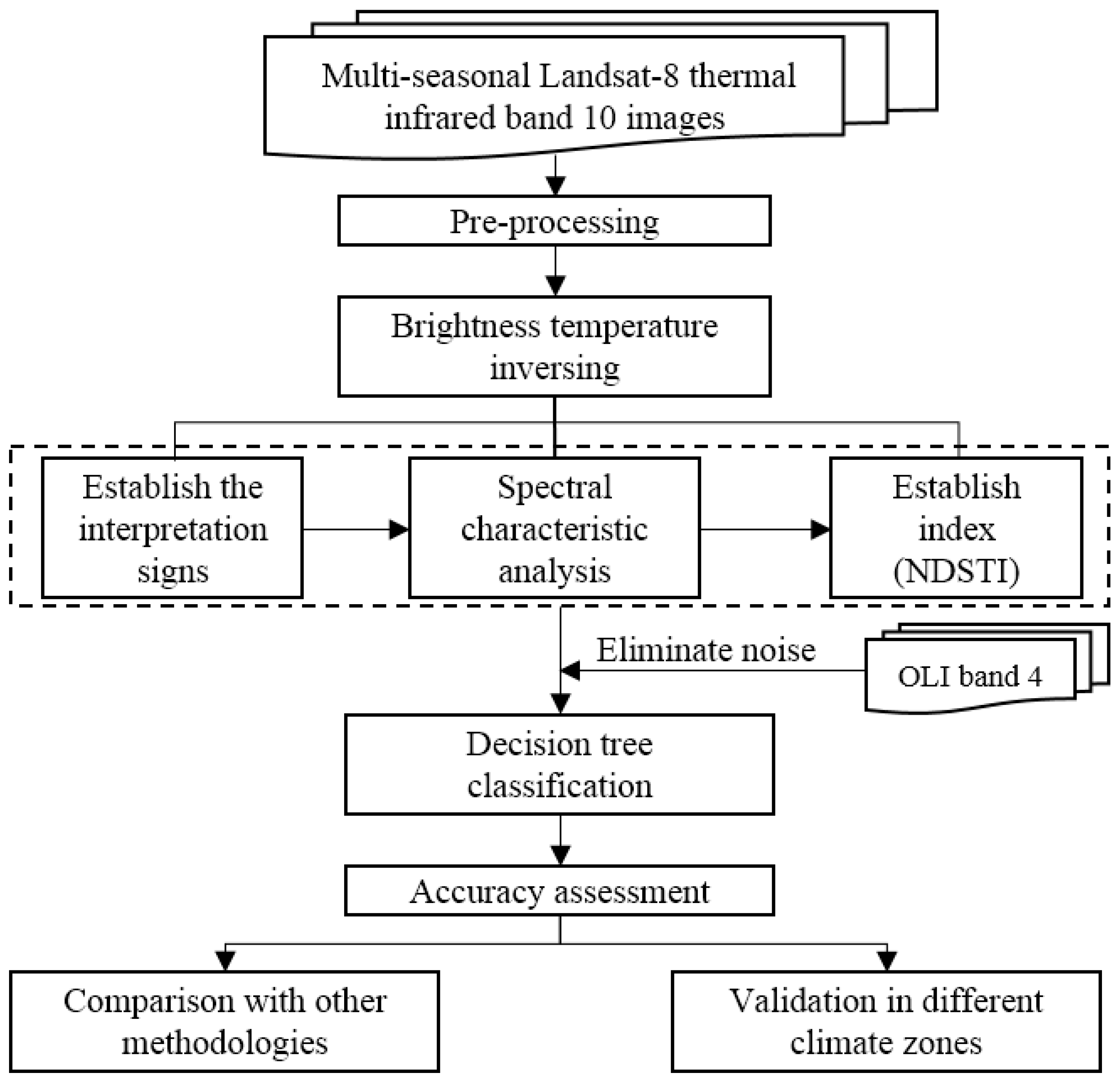

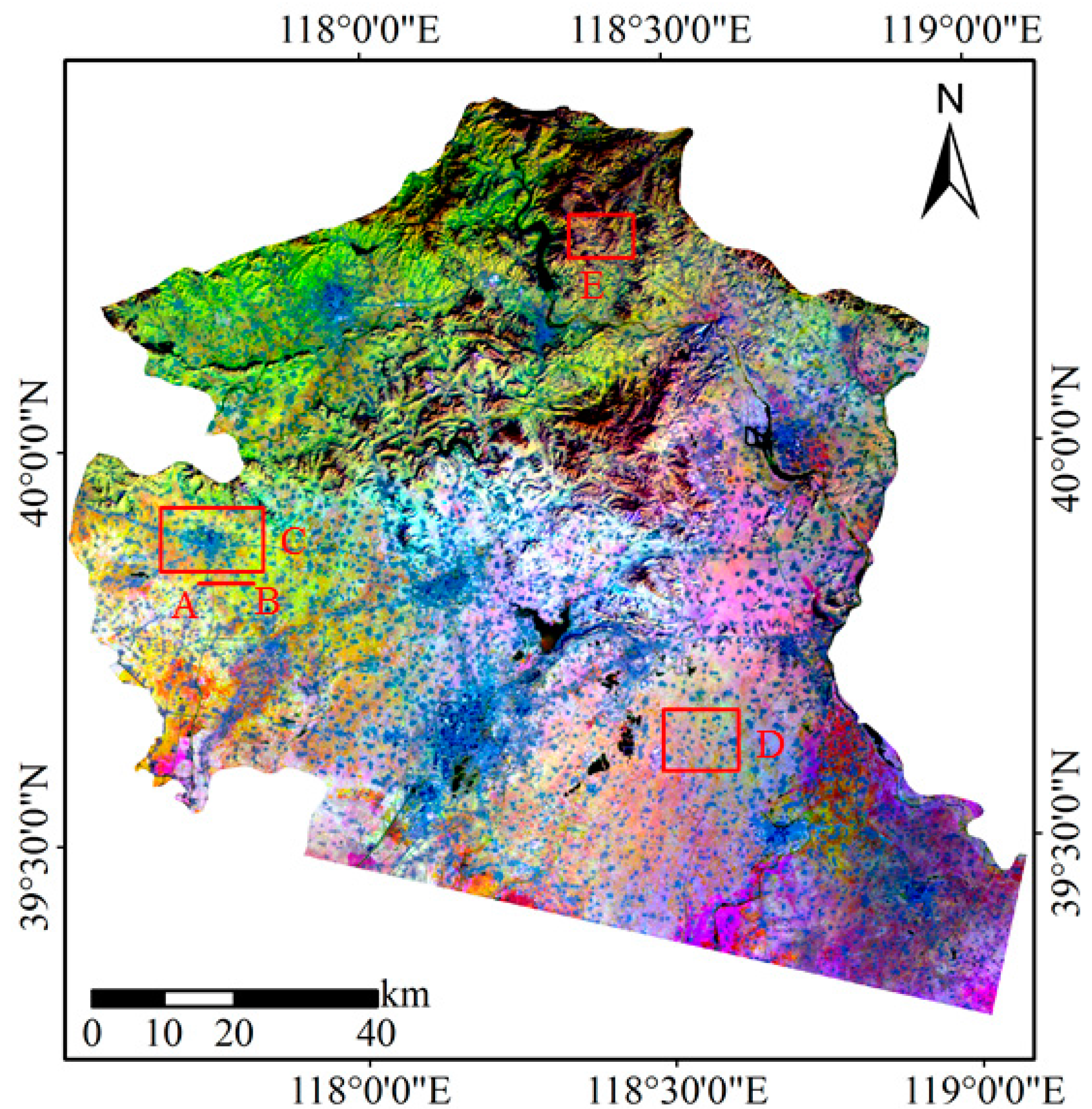

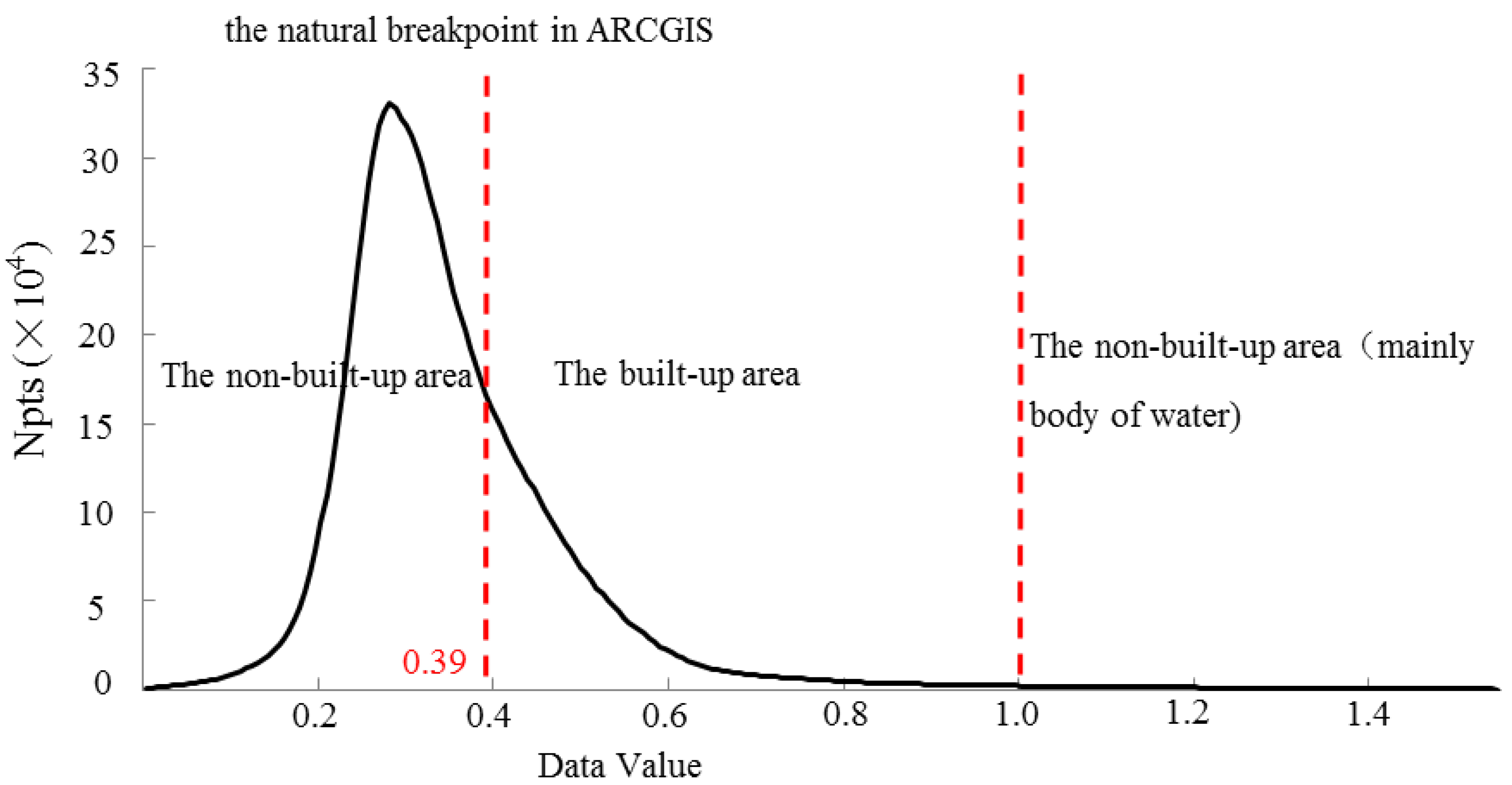
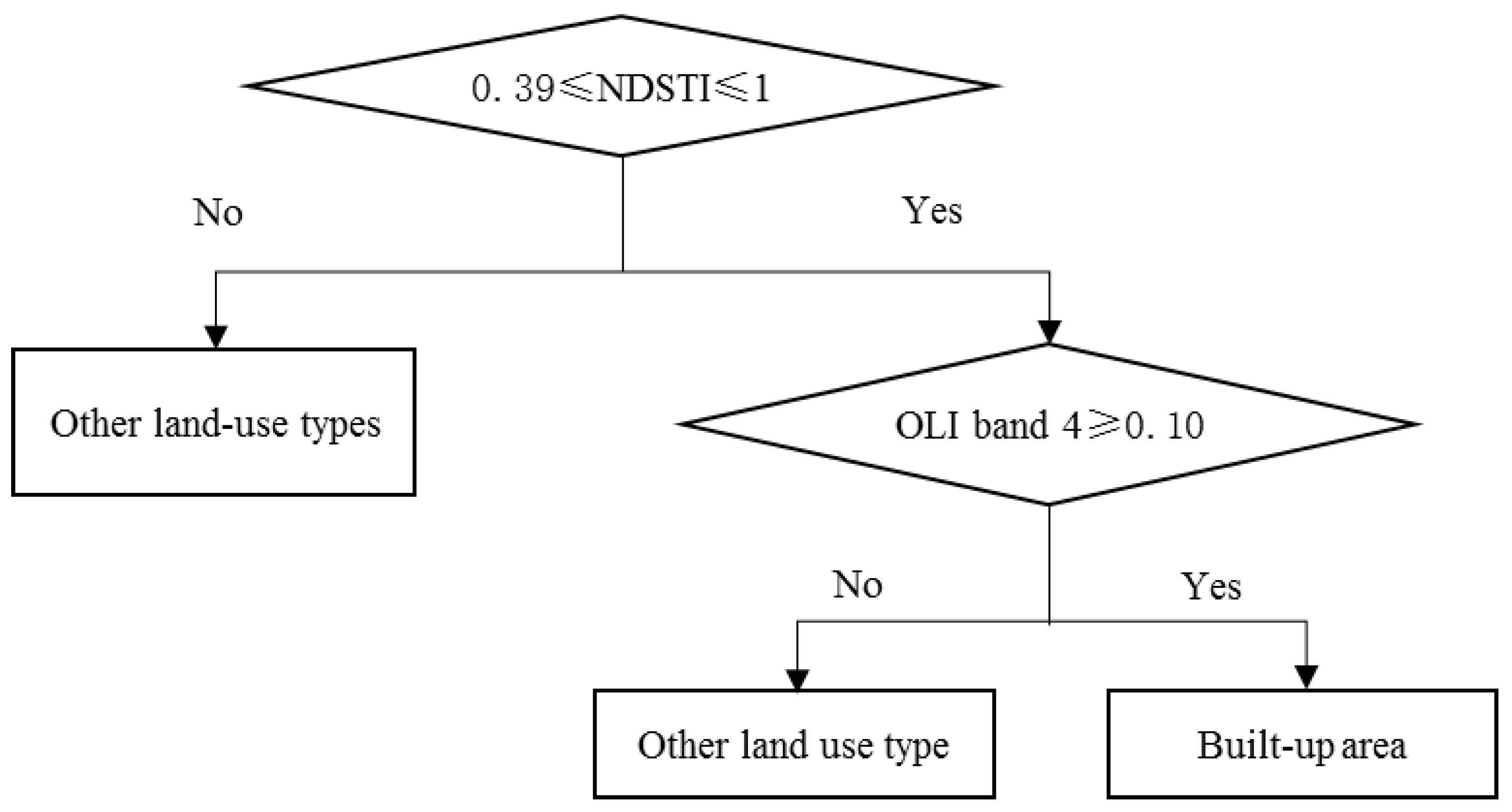
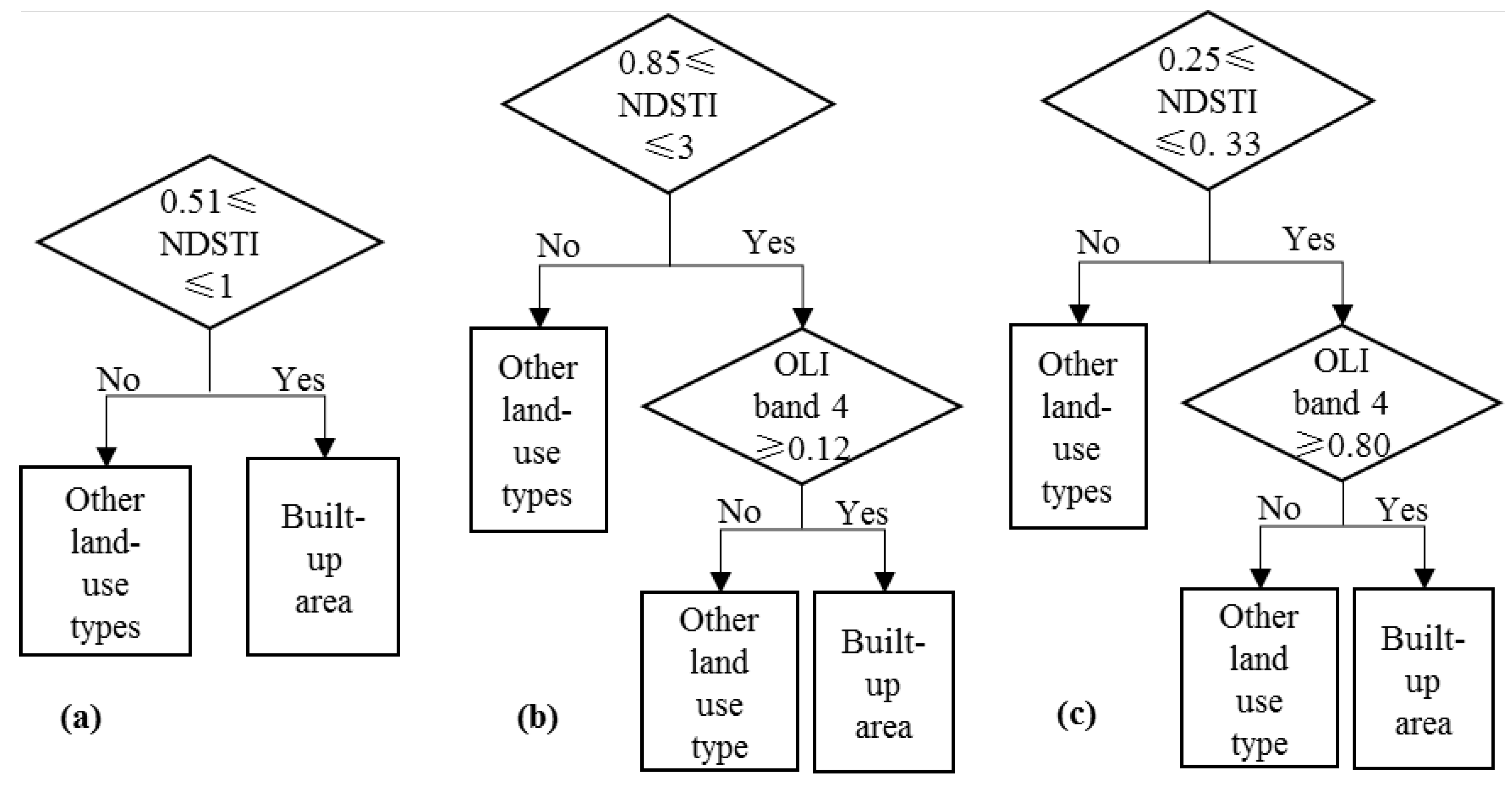
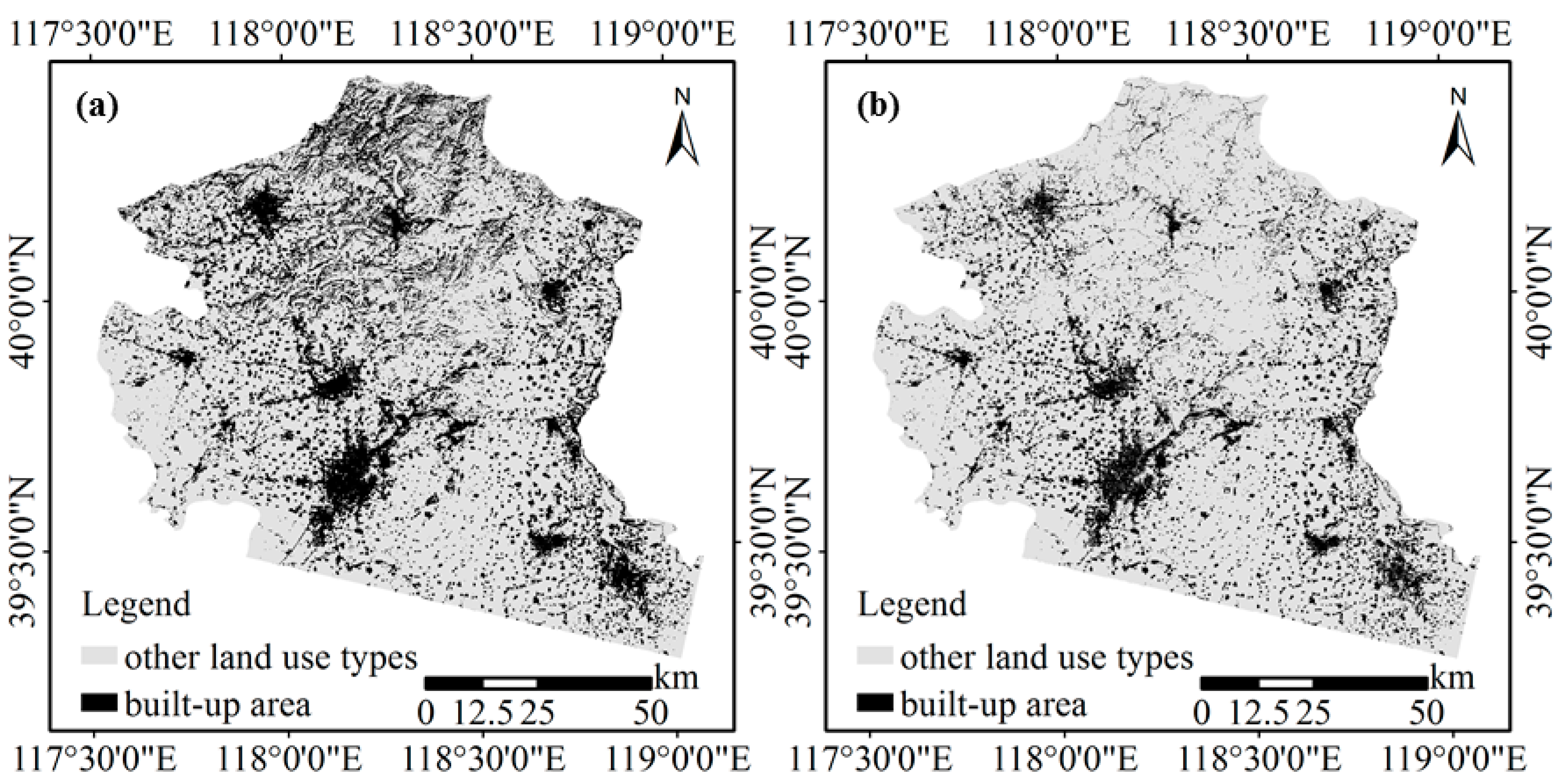

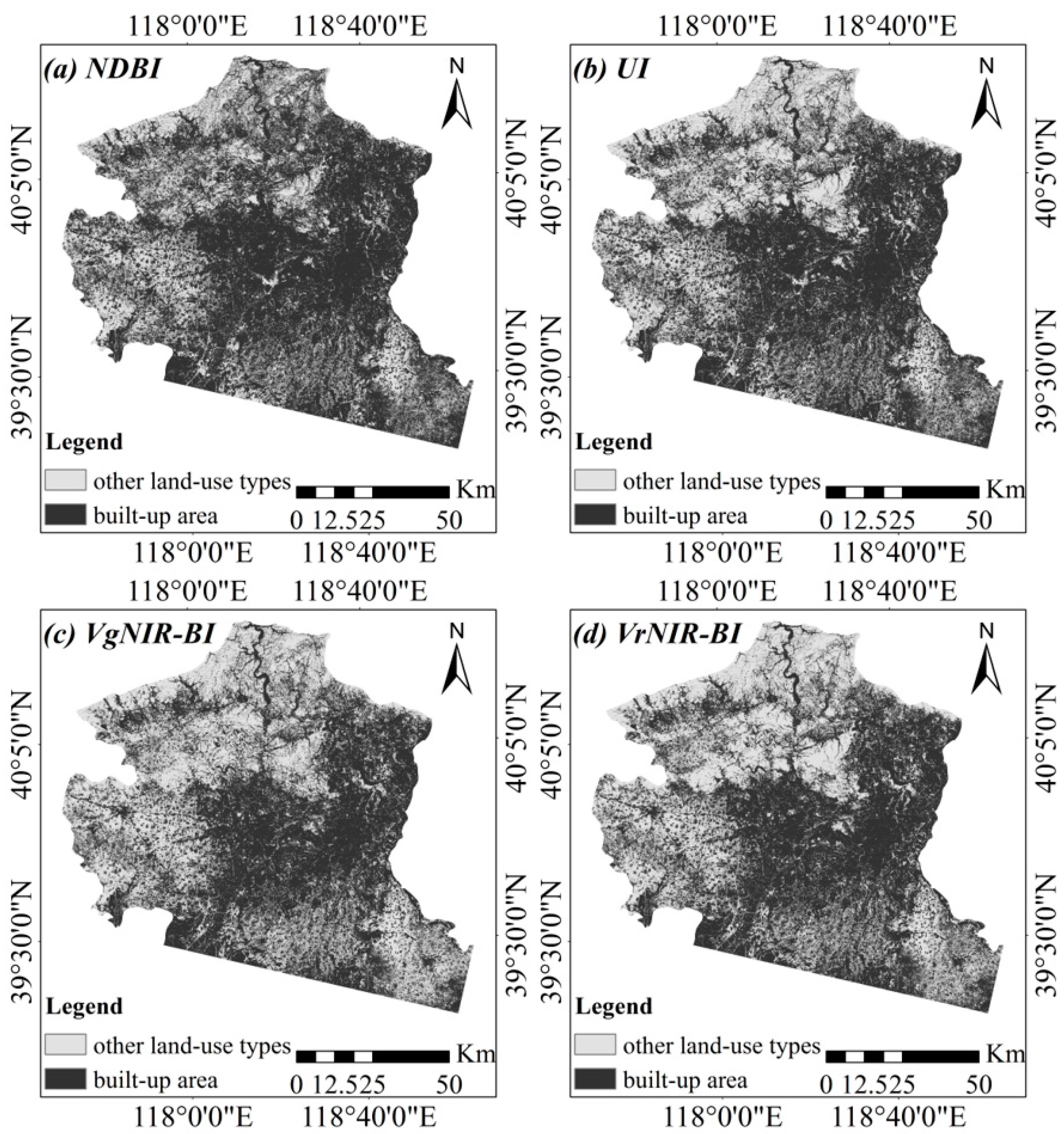
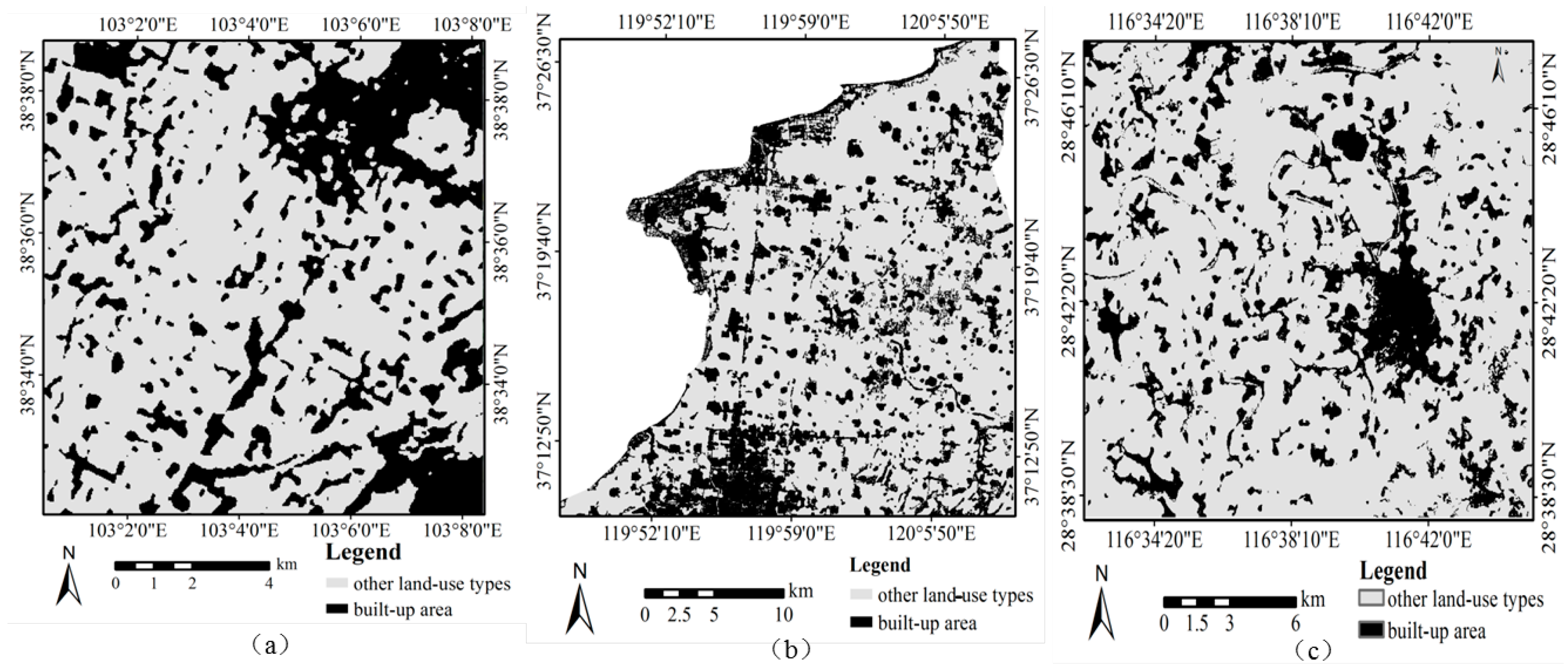
| Area Name | Year | Date | Mean Temperature | Path/Row | Range |
|---|---|---|---|---|---|
| Tangshan | 2016 | 2/7 | −1.5 °C | 122/32 | 117°31′–119°19′E; 38°55′–40°28′N |
| 3/10 | 5 °C | 122/32 | |||
| 5/13 | 19.5 °C | 122/32 | |||
| Minqin | 2015 | 1/2 | −8 °C | 131/33 | 103°00′–103°08′E; 38°32′–39°38′N |
| 2/19 | −4.5 °C | 131/33 | |||
| 6/11 | 21 °C | 131/33 | |||
| Laizhou | 2016 | 1/8 | −2.5 °C | 120/34 | 119°47′–120°09′E; 37°10′37°27′N |
| 3/12 | 9 °C | 120/34 | |||
| 7/2 | 28 °C | 120/34 | |||
| Yugan | 2016 | 2/16 | 9 °C | 121/40 | 116°32′–16°44′E; 28°38′–28°47′N |
| 3/3 | 14.5 °C | 121/40 | |||
| 6/23 | 26.5 °C | 121/40 |
| The OLI False Color Composite Visible-Infrared Image (Band 7 (R), Band 6 (G), and Band 4 (B)) | The False Color Composite Image of Three-Date Brightness Temperature (7 February (R), 10 March (G) and 13 May (B)) | |
|---|---|---|
| Interpretation signs | 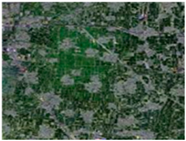 | 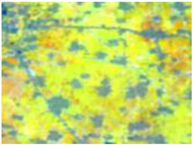 |
| explanation | The color of the built-up area is light gray or pale purple and heterogeneous. Their boundary is ambiguous and easy to confuse with the surroundings. | The color of built-up area is light blue and homogeneous. Their boundary is clear. The spatial location is explicit. |
| Built-Up Area | Non-Built-Up Area | Student’s t-Test | |||||||||
|---|---|---|---|---|---|---|---|---|---|---|---|
| Min | Max | Mean | SD | Min | Max | Mean | SD | t | P | ||
| brightness temperature | 2/7 | 3.60 | 5.77 | 4.65 | 0.52 | 7.61 | 9.89 | 8.68 | 0.62 | −47.47 | 0.00 |
| 3/10 | 7.42 | 10.73 | 9.42 | 0.61 | 12.07 | 14.73 | 13.35 | 0.68 | −40.83 | 0.00 | |
| 5/13 | 25.29 | 27.78 | 26.66 | 0.83 | 22.52 | 26.11 | 24.13 | 0.83 | 20.47 | 0.00 | |
| NDSTI | 0.44 | 0.48 | 0.46 | 0.01 | 0.21 | 0.24 | 0.23 | 0.01 | 203.77 | 0.00 | |
| Methodology | Ground Truth | Overall Accuracy (%) | Kappa | |||
|---|---|---|---|---|---|---|
| Built-Up Area | Non-Built-Up Area | Total | ||||
| NDSTI | Built-up area | 88 | 45 | 133 | 83.60 | 0.57 |
| Other land use types | 37 | 330 | 367 | |||
| Total | 125 | 375 | 500 | |||
| NDSTI-Red | Built-up area | 105 | 31 | 136 | 89.80 | 0.74 |
| Other land use types | 20 | 344 | 364 | |||
| Total | 125 | 375 | 500 | |||
| Methodology | Producer Accuracy (%) | User Accuracy (%) | Overall Accuracy (%) | Kappa |
|---|---|---|---|---|
| NDBI | 86.40 | 31.12 | 48.80 | 0.14 |
| UI | 85.60 | 34.74 | 56.20 | 0.23 |
| VgNIR-BI | 90.45 | 62.94 | 75.00 | 0.51 |
| VrNIR-BI | 90.00 | 63.16 | 75.00 | 0.50 |
| NDSTI | 85.17 | 68.20 | 83.60 | 0.57 |
| NDSTI-Red | 86.00 | 77.20 | 89.80 | 0.74 |
| Regions | Producer Accuracy (%) | User Accuracy (%) | Overall Accuracy (%) | Kappa |
|---|---|---|---|---|
| Tangshan | 84.00 | 77.20 | 89.80 | 0.74 |
| Laizhou | 97.37 | 88.10 | 91.00 | 0.88 |
| Yugan | 97.14 | 66.67 | 88.00 | 0.71 |
| Minqin | 51.85 | 70.00 | 81.00 | 0.48 |
© 2017 by the authors. Licensee MDPI, Basel, Switzerland. This article is an open access article distributed under the terms and conditions of the Creative Commons Attribution (CC BY) license (http://creativecommons.org/licenses/by/4.0/).
Share and Cite
Zhang, P.; Sun, Q.; Liu, M.; Li, J.; Sun, D. A Strategy of Rapid Extraction of Built-Up Area Using Multi-Seasonal Landsat-8 Thermal Infrared Band 10 Images. Remote Sens. 2017, 9, 1126. https://doi.org/10.3390/rs9111126
Zhang P, Sun Q, Liu M, Li J, Sun D. A Strategy of Rapid Extraction of Built-Up Area Using Multi-Seasonal Landsat-8 Thermal Infrared Band 10 Images. Remote Sensing. 2017; 9(11):1126. https://doi.org/10.3390/rs9111126
Chicago/Turabian StyleZhang, Ping, Qiangqiang Sun, Ming Liu, Jing Li, and Danfeng Sun. 2017. "A Strategy of Rapid Extraction of Built-Up Area Using Multi-Seasonal Landsat-8 Thermal Infrared Band 10 Images" Remote Sensing 9, no. 11: 1126. https://doi.org/10.3390/rs9111126




